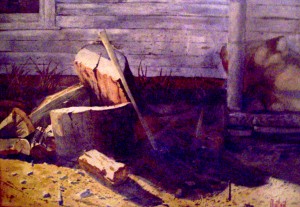Transparent watercolor tends to be for single layering with an order from light to dark. Most artist using this method generally think in terms of single layering. They either paint around or mask the light or white areas first to preserve the white of the paper. After this, they address the dark area and use the light value of the surface to provide the lightest value of the painting.

I started to use this technique for the painting, Winter Kindling. However, before the paining was finished, there were some areas that I layered over. It turned out to be an experiment with a multiple layering of transparent watercolors mostly in the shaded area while holding true to a single layer in the lighter value areas.
The lightest values are the white of the paper. The mid values are mixed colors and the shaded area is transparent layering–or glazing.
Sometimes your painting does not turn out the way you originally intend. Sometimes it is better and sometimes it is not. Sometimes the problem in not having a good layering plan. It is all in the sequence. You have to have a logical order to establish the work you wish to proceed. Planning that sequence in which areas of paint are to be applied is important.
Work in a logical order and prevent the frustration of not knowing whether to “fix” a problem (as I did in the Winter Kindling) or throw the whole thing away and start over. Let the order of your sequence be logical. It’s as simple as painting the sky before you paint trees and grass.
